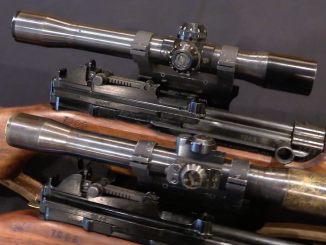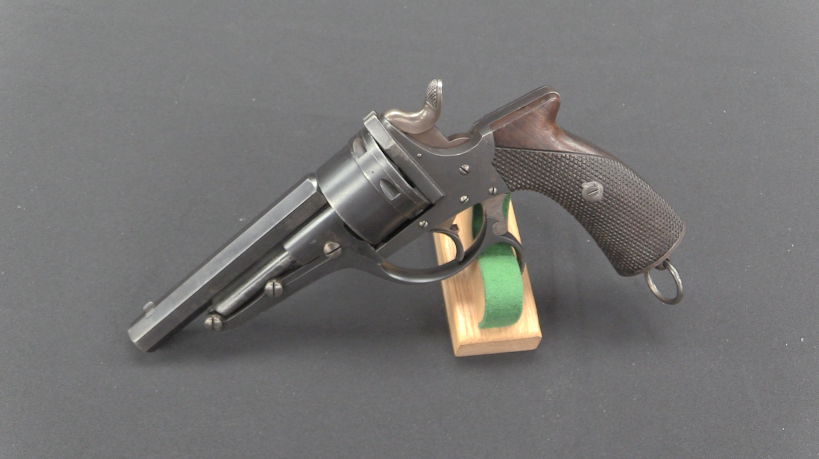Produced by Alexandre Fagnus of Liege, this is a military style, six-shot, .450 caliber revolver with a particularly interesting and unusual unloading mechanism. The rear half of the trigger guard is a lever which can be rotated 90 degrees out from the frame, unlocking the barrel and cylinder. The front half of the trigger guard then acts as a second lever to pivot the action open around the rear sight and operate the spring loaded ejector star. The gun dates to roughly the late 1870s or 1880s, and I was not able to find any information on production quantity or even the specific cartridge it is chambered for.
Related Articles

Semiauto pistol
Bergmann M1910 and 1910/21 Pistol

Semiauto Rifles


Some more info and photos here; http://www.littlegun.be/arme%20belge/artisans%20identifies%20e%20f%20bis/a%20fagnus%20gb.htm
Looking at patent drawing in link, for me it looks similar aesthetic-wise to Galand 1870 revolver. http://www.imfdb.org/wiki/Galand_Revolver
“late 1870s or 1880s”
It is possible that it was inspired by Mauser Zig-Zag, which also has version breaking for reloading to up? See 2nd photo from top here:
http://jamesdjulia.com/item/lot-3206-ultra-rare-last-model-mauser-zigzag-revolver-52565/
“Littlegun” link states, this pistol was patented in 1870 and the text of “Jammesjulia” has a statement that Mauser Patent was registered in 1878. The similarity between the two in the way of upper frame opening and extraction is evident but the way of releasing form seems different.
There were various upward tippin revolvers with simultaneous ejection of cartridges:
Gerard, adopted by Brasil
Spirlet
Mauser “Zig-Zag”
Hill
Also, S&W Model 1 (and revolvers inspired by it) has top hinge, though it was designed to allow cylinder removal and cases unloading.
–
I wonder about advantages/disadvantages of bottom/top hinge. Bottom hinge seems to be more popular, and loading seem more convenient that way, but on the other hand bottom hinge mean gravity will help in unloading.
What attracted my attention is the low profile of the front sight which usualy looks at most of the revolvers higher than the rear’s. This should be from the fact that most of the masses joining at the front section.
Fagnus later made more conventional solid frame revolver that was very popular among French officers due the being more simple (Galand single V spring mechanism), safe (very positive hammer rebound) easier to clean (side plate would swing out like on Rast Gasser and Type 26) and fantastically well made.
Ferdinand Foch owned one.
Tip up revolvers like the S&W which tipped up at the front of the cylinder were fairly weak in their construction. This revolver’s designer seems to have taken care to give it the strength to fire a much more useful cartridge, albeit at the cost of complexity.
“fairly weak in their construction.”
But “tip-up” construction was enough for self-defense cartridge of that era. For example Marlin produced “Standard 1878” revolver with cylinder holding 5 .38 S&W center-fire cartridges, see photos here: http://www.american-firearms.com/american-firearms/z-html/company-M/Marlin,%20J.%20M/Marlin,%20J.%20M.html
I am wondering how powerful cartridge could be harnessed in tip-up revolver, using modern technology?
Around that time (1870s to 1880s) there were a lot of small companies in Belgium and France making revolvers both for commercial sale and use by military and police. (This contrasts sharply with the modern era caused by restrictive legislation.)
And a lot of those makers were trying to figure out how to make and sell simultaneous-ejection revolvers without falling foul of both Smith & Wesson’s and Webley’s patents on top-break, automatic simultaneous ejection. Rather as American revolver makers battled S&W and Rollin White for nearly two decades.
I suspect this design is one such “patent evasion”. First of all, it breaks upward rather than down, and second, it is a hand ejector. You have to crank the front of the trigger guard down manually to operate the ejector, instead of it being done automatically. Thus getting around the bases of both the S&W and W&S patents.
Actually, except for being a bottom-frame-break instead of a swingout cylinder, the ejector system is closer to the William Mason-Remington patent of 1866 that formed the basis of most solid-frame, swingout cylinder hand ejector revolvers down to the present day.
cheers
eon
“it is a hand ejector”
This might also purpose for advertising – some customer might don’t like all-at-once automatic ejection as it would also throw not fired cartridges (see British Enfield Mk II Revolver designed to throw only empty cases)
Interestingly modern MP-412 REX (Revolver, Export) for .357 Magnum:
http://modernfirearms.net/handguns/double-action-revolvers/rus/izhmeh-mp-412-e.html
has automatic ejection which might be deactivated.
hann2160Wonder boy!!! beautiful personality love you Charlie Green Keep on singing for us love to hear you.. Dahil sayo is my favourite song even though I don’t understand the words – being Chasnee..hahi..